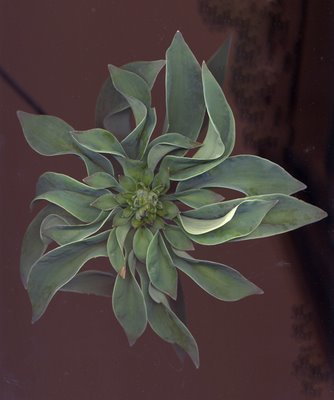A Beautiful Aberration
Wednesday, May 30, 2007

Hostas are generally prized for their leaves, particularly when they are variegated. Not many notice hosta flowers some of which can be extremely fragrant. Some flowers are striped and some are beautiful before they even open as they look like the beaks and heads of exotic oriental birds. The flowers of Hosta clausa are notable in that they never open.
I love hostas and spend time placing them so that they will look their best. If you plant a blue hosta next to a gold hosta the gold hosta will look golder and the blue one bluer. But hostas are not really blue or gold. The blue ones as defined by W. George Schmid in his The Genus Hosta
Blue-green (enhanced by temporary surface effects). A dull green passing into greyish blue, usually associated with a glaucous, caesious, pruinose, or glaucescent surface.
Some people believe that the "blue" coating of blue hostas (sometimes called the bloom) protects the plant from the harsh UV rays of the sun. Many blue hostas originated in the high mountain areas of Japan. This blue coating reflects UV in the same way as sun block does. When you photograph a blue hosta (specially in the shade with the added blue of shade) it will look an unnatural blue. The reason is that both film and digital cameras are more sensitive to UV than we humans are.
Hosta 'Buckshaw Blue' is one of the bluest of my blue hostas. It has white flowers. By the beginning of June the leaves are a startling blue-green. This year Buckshaw Blue surprised me with a vegetative aberration (hosta experts are not sure why hostas do this) that is a combination of a large hosta flower with extra thick, small and narrow leaves. The whole structure which I would call a rosette is 8 inches across.
Blue hostas remain blue longer in our cooler climates. In the south of the US with their hot and humid climate the bloom disappears by the end of June while in Vancouver the colour persists well into August. It is not polite to touch a blue hosta as touch will leave a blemish and you will never be invited to that garden again.
Addendum by W. George Schmid
As you do, I like those large crowns of bracts (a true bract is protective leaf covering usually associated with a developing flower). Bracts is what I call these scape/raceme leaves. You must have has more rain than normal. During very wet weather, the bracts sometimes grow larger and become leaf-like and get way ahead with their growth process before scape/raceme elongation separates the bracts longitudinally and the "crown dissolves." In the fold of each of the upper bracts hides a flower and that is why they are called fertile bracts. These fertile bracts may be joined by several bracts emerging below the fertile bracts. These do not have a flower hiding in the "wings." They are sterile bracts, sometimes called bracteole. As stated above, the whole leafy menagerie is occasionally way ahead of scape/raceme elongation and flower development and so grows into a leafy cluster. The right genetic background also helps in the development of these flamboyant bud covers (looking much like a leafy crown), to wit, one of its grandparents (in the H. sieboldiana/H. ' Tokudama' group) regularly goes though a stage in its growth cycle, when the bracts form a similar leafy crown, but not as exaggerated as the one seen in your picture. Other hostas also form these leafy structures, like the one (shown on plate 138 of my book) on H. 'Undulata'). Enjoy it when and while you can, it may not develop this way next year. I love Nature, it is so much more entertaining than TV.
Greetings from the very dry South, George
W. George Schmid
Hosta Hill R. G.
USDA Zone 7a - 1188 feet (361m) AMSL
84-12'-30" W 33-51' N






